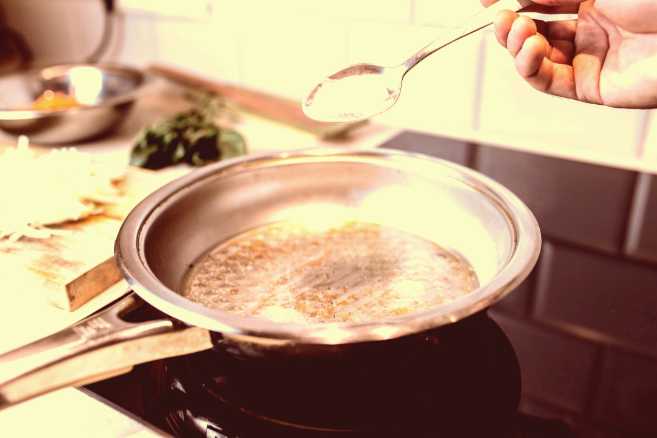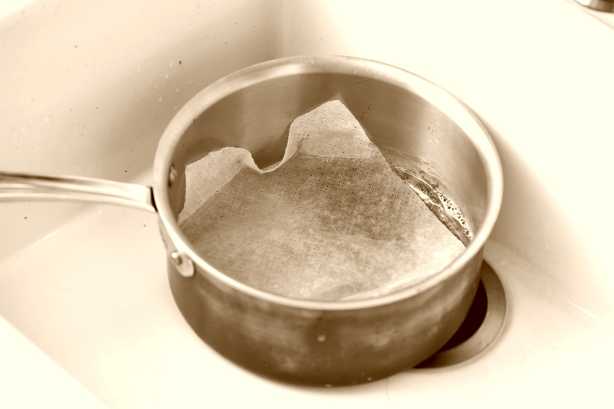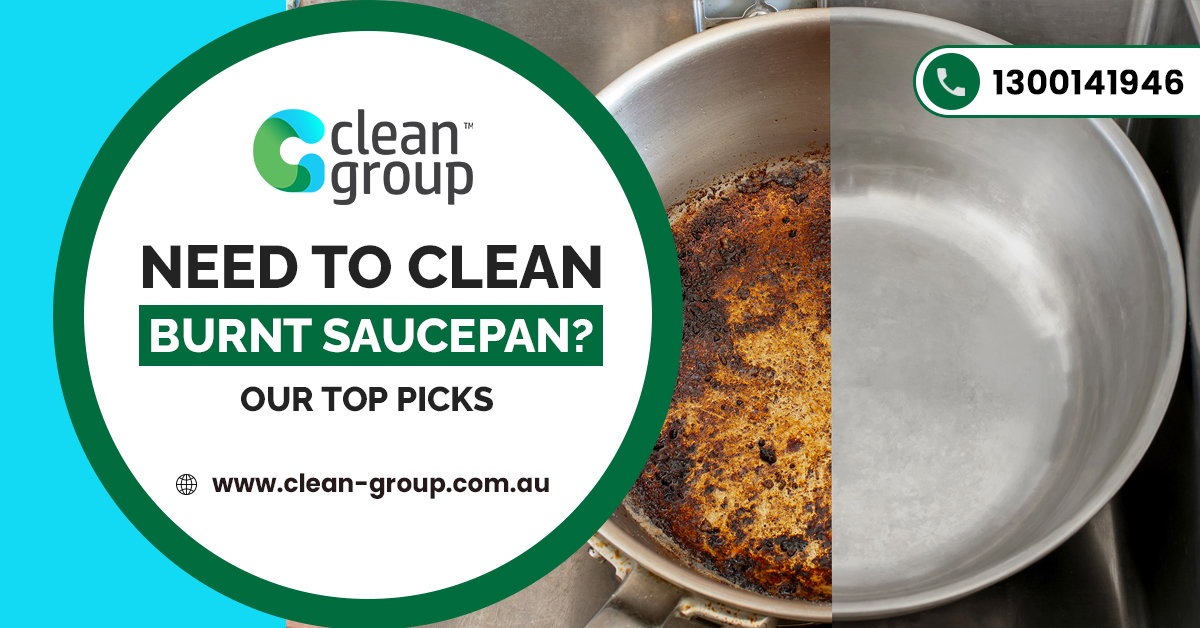Whether you completely burn supper or your pans become increasingly dirty over time, you need to scour them at the sink at some point. As a result, we put nine commercial cleaning solutions for a burnt pan to the test.
Continue reading to find out how to clean a burnt pan and which methods are the most efficient.
Warning: Test the method on a small, unnoticeable area before cleaning your pans to ensure that it doesn’t damage the surface. The instructions below are for stainless steel cookware only, not for non-stick cookware.
| Method | Time | Effort | Ingredients | Best For | Notes |
|---|---|---|---|---|---|
| Vinegar & Baking Soda | 15m | Medium | Common kitchen items | Light-to-medium burns | May fizz—ensure ventilation |
| Dishwasher Tablet | 30m+ | Low | Commercial cleaning tab | Deep burns | Soaking time required |
| Bar Keepers Friend | 5m | Medium | Specialty product | Heavy residue | Avoid on non-stick/copper |
| Dryer Sheet | 1hr+ | Low | Household dryer sheet | Light char | Not suitable for food surfaces |
Method 1: Water, Vinegar, and Baking Soda

Bring one cup of water and one cup of vinegar to a boil in a saucepan. Remove the pan from the heat and stir in two teaspoons of baking soda. Then, remove the liquid and scrub the pot with a scour.
If you still have stuck-on particles, mix a paste with more baking soda and water and let it sit for a few minutes before washing it with a scour and dishwashing soap.
Method 2: Lemons
Slice two to three lemons and arrange them in a burnt pan. Fill the pan with just enough water to just immerse the lemons and place it over medium-high heat. Remove the pan from the heat after bringing the lemon water to a boil for five to eight minutes.
When you notice particles of food floating to the water’s surface, you know the pan is set for a final clean. Drain the water and toss out the lemons. Use a scour or brush to soften and remove any stuck-on pieces after rinsing with hot, clean water.
Method 3: Bar Keepers Friend
Drain your dirty pan after running it under hot water. Then, with protective gloves on, prepare a paste by rubbing a few teaspoons of Bar Keepers with the water left in the unclean pan. Allow 60 seconds for the paste to rest on the charred debris in the pan; don’t wait any longer.
After 60 seconds, rinse your saucepan completely with hot water and scrape away the loose burnt-on food with a brush, sponge, or scour. If any tough spots remain, repeat the process.
Method 4: Dishwasher Tablet
Another option for recovering burnt pans is to use dishwasher detergent. To begin, fill the pot with one dishwasher tablet, one tablespoon of powdered dishwasher detergent, or one teaspoon of dishwashing liquid. Then, fill it halfway with scalding hot water from your tap and soak it for at least 30 minutes.
Next, carefully scrape the bottom of the saucepan with a plastic spatula or wooden spoon, testing to see if the burnt food bits easily come off the surface.
If this is the case, drain the soapy water and scrub away any leftover residue. However, if not, increase the heat by boiling the water-and-detergent mixture for about 10 minutes on the stove.
Remove the pot from the stove and soak it as it cools before tossing out the liquid and scrubbing away any remaining filth.
Method 5: Boiled Lemons
Fill the pan with a few inches of water and bring to a boil with two or three quartered lemons. Cook for five to 10 minutes or until food particles begins to rise to the surface. Remove any remaining particles with a scour after discarding the water and lemons.
Method 6: Aluminium Foil and Baking Soda
Drain your dirty pot after rinsing it in hot water. Then, generously sprinkle two tablespoons of baking soda on top and scrub with a golf ball-sized piece of folded foil after adding a few teaspoons of hot water back to the pan. Scrub until all the charred material has been lifted, then rinse with warm soapy water to complete the cleaning process.
Method 7: Biological Detergent
Leave the pan to cool before filling it with water and one tablespoon of organic laundry detergent. Biological detergents contain enzymes that are specifically intended to remove food stains, and they also work on burnt-on food residue. Return the pan to the stovetop and heat to a boil.
Allow to simmer for around 10 minutes, and the burnt parts will easily lift away, restoring your pan to its original state. Repeat as needed, then thoroughly wash as usual. This approach can also be used with hob-safe roasting tins.
More Post: About Commercial Kitchen Canopy Cleaning Sydney
Method 8: Boiling Water
This cleaning method entails returning to the source of the problem the stove. Fill the saucepan halfway with water, or just enough to cover the burnt area. Bring the water to a boil, then set aside for five to seven minutes to cool.
After that, take the pot from the heat and lay it aside to cool. Pour away the water once it has reached room temperature. If necessary, carefully scrape any large, now softened, charred chunks into the rubbish bin with a plastic spatula or wooden spoon.
Finally, add two teaspoons of baking soda to the wet pan and scrape any leftover spots with a scour or sponge. The black residue should come off much easier, especially if you use an abrasive baking soda paste.
Method 9: Dryer Sheet

Did you know that most dryer sheets have conditioning characteristics that might help release burnt residues from your pots and pans? This is how you do it:
Submerge a dryer sheet in a few inches of warm water in the charred pan. Allow the mixture to rest for at least one hour overnight, then discard the dryer sheet and drain the water.
Scrub any remaining food bits with a sponge, and then thoroughly clean the pan with your regular washing technique to remove any material left by the dryer sheet.
More Post: What Does A Spring Cleaning Checklist Include?
Scientific Explanation or Cleaning Principle Breakdown
While the methods are practical and varied, the article misses an opportunity to educate readers on why each method works. Providing a basic explanation of the underlying cleaning principles would not only enhance trust and authority but also help readers adapt or troubleshoot these methods.
For example:
- Baking Soda – Acts as a mild abrasive that helps lift residue and neutralize odors.
- Vinegar – An acidic solution that breaks down mineral deposits and softens burnt-on material.
- Lemon Juice – Contains citric acid, which has a similar degreasing and lifting effect to vinegar.
- Bar Keepers Friend – Contains oxalic acid, which effectively removes rust and burn marks on metal surfaces.
- Biological Laundry Detergent – Includes enzymes that break down proteins and starches commonly found in food residue.
- Dryer Sheets – Often coated with fabric softeners and surfactants that help loosen debris, but they may leave residue and are not food-safe.
Conclusion
Although all of these methods are excellent in removing the dirt from your skillets, we believe the dishwasher tablets are a clear winner. While we can’t speak for other types of dishwasher tablets, we believe they’d be just as good at removing grease and burned-on food.
Whereas the dishwashing tablet was our favourite solo approach, we think the others—especially Bar Keepers Friend and the aluminium foil with baking soda—are also excellent alternatives if you’re ready to put in a little extra effort or elbow grease.

